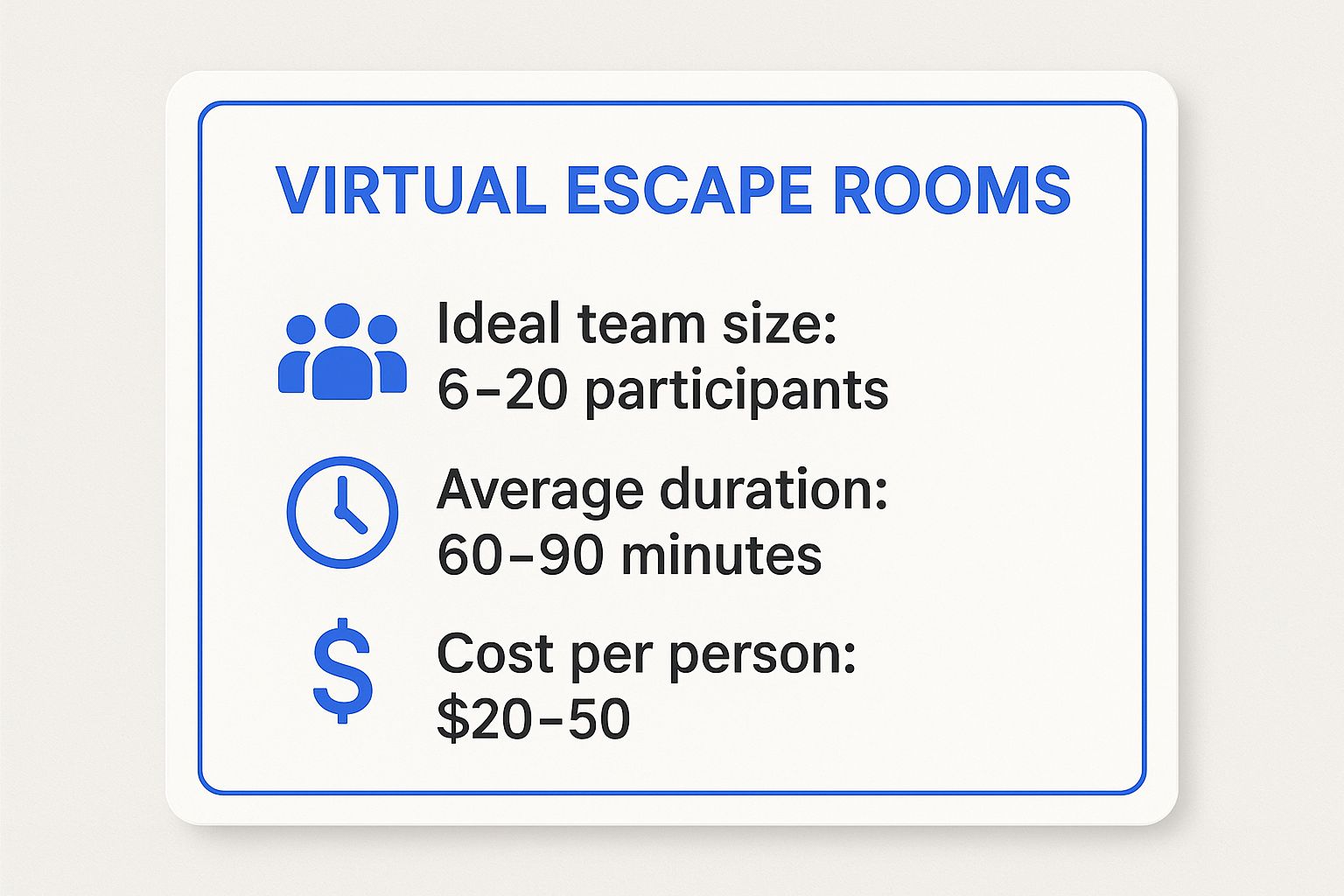Top Virtual Team Building Activities to Boost Remote Collaboration

In a remote work environment, fostering genuine team connection is no longer an optional perk; it's a fundamental requirement for success. Spontaneous conversations by the coffee machine or shared lunches have been replaced by scheduled video calls, making intentional efforts to build rapport more critical than ever. Without these structured opportunities, a sense of isolation can easily take root, impacting collaboration, morale, and overall productivity. This is where strategic virtual team building activities become indispensable.
This guide is designed to move your team beyond the standard virtual happy hour. We've compiled a detailed list of creative, engaging, and effective activities that build real bonds, spark laughter, and boost communication among distributed colleagues. You'll find practical, step-by-step instructions for implementing everything from collaborative virtual escape rooms to energizing online game tournaments and skill-sharing workshops. Each idea is crafted to be more than just a fun break; they are tools to cultivate a resilient, connected, and high-performing remote culture. Forget awkward small talk and get ready to discover actionable strategies that will help your team thrive, no matter where they're located. Let's dive into the activities that will bridge the distance and strengthen your team's foundation.
1. Virtual Escape Rooms
Virtual escape rooms are one of the most immersive and collaborative virtual team building activities available today. Teams join a live video conference where a host guides them through a themed digital environment filled with puzzles, riddles, and hidden clues. The objective is to work together, communicate effectively, and solve the mystery to "escape" before the clock runs out.
These experiences are powerful because they require a diverse range of skills, from logical reasoning to creative problem-solving, ensuring everyone has an opportunity to contribute. Companies like Google and Netflix use platforms such as The Escape Game and Puzzle Break for quarterly team events, leveraging these activities to boost morale and strengthen teamwork in a high-stakes, yet fun, environment.
How to Implement a Virtual Escape Room
Successfully hosting a virtual escape room involves more than just booking a session. The key is in the preparation and follow-up.
- Choose the Right Challenge: Select a theme and difficulty level that matches your team's personality and experience. A group new to escape rooms may prefer a lighthearted mystery, while a team of engineers might enjoy a complex, logic-based challenge.
- Facilitate Cross-Functional Teams: Intentionally mix members from different departments. This encourages new perspectives and helps break down organizational silos, fostering better company-wide communication.
- Conduct a Post-Game Debrief: Immediately after the event, hold a 15-minute discussion. Ask questions like, "What was our biggest communication challenge?" or "How did we leverage each other's strengths?" This transforms a fun game into a valuable learning experience.
For a quick reference on planning your event, this summary box outlines the typical logistics for virtual escape rooms.

As the data shows, these activities are accessible and efficient, fitting within a standard meeting block and budget, making them a practical choice for most teams. This combination of high engagement and low logistical overhead is why virtual escape rooms are a top-tier option for remote team building.
2. Online Trivia Competitions
Online trivia competitions are engaging and highly adaptable virtual team building activities that test knowledge and encourage friendly rivalry. Teams join a video call where a host, or an automated platform, presents questions across diverse categories. The goal is to collaborate, submit answers quickly, and earn the most points, fostering communication and team strategy in a low-pressure, exciting format.
This classic activity is powerful because it's easily customizable to fit any team's culture and interests, from pop culture to company-specific facts. Organizations like Microsoft use platforms such as Kahoot! for monthly team engagement, while Buffer uses QuizBreaker for asynchronous connection. These games reinforce knowledge, spark conversation, and provide a reliable way to boost team spirit.
How to Implement Online Trivia Competitions
Hosting a successful trivia event requires more than just good questions; it's about creating an inclusive and dynamic experience.
- Customize Your Content: Include questions about your company's history, inside jokes, or team members' hobbies. This personalizes the game and reinforces a shared culture far more effectively than generic trivia.
- Leverage Breakout Rooms: For team-based trivia, use breakout rooms to allow groups to strategize before submitting an answer. This promotes deeper collaboration and ensures everyone's voice is heard, rather than just the fastest person to type.
- Balance Question Difficulty: Create a mix of easy, medium, and hard questions. This ensures that everyone feels capable of contributing and keeps the game engaging for all participants, regardless of their trivia expertise.
For a quick reference on planning your event, this summary box outlines the typical logistics for online trivia.
As the data highlights, these activities are both budget-friendly and quick to organize, making them perfect for regular, spontaneous team bonding. The combination of easy setup, high participation, and customizable content makes online trivia a go-to choice for consistently strengthening remote teams.
3. Virtual Coffee Breaks and Watercooler Chats
Virtual coffee breaks are intentionally informal video meetings designed to recreate the spontaneous, personal conversations that happen in a physical office. These sessions provide a dedicated space for remote teams to connect on a human level, moving beyond work-related agendas. They are one of the simplest yet most effective virtual team building activities for fostering genuine relationships and a strong, positive company culture.
This practice is powerful because it combats the isolation that can accompany remote work. It gives team members a low-pressure outlet to share personal stories, discuss hobbies, and build camaraderie. Companies like Zapier and Shopify use automated tools like Donut to randomly pair thousands of employees for these chats, successfully scaling informal connection across a massive, distributed workforce and making everyone feel like part of a cohesive team.
How to Implement Virtual Coffee Breaks
To make these sessions successful, you must be intentional about creating a casual and inclusive atmosphere. It's about structuring spontaneity without forcing it.
- Use Automation to Facilitate Connections: Implement tools like Donut or RandomCoffee.io, which integrate with platforms like Slack, to automatically pair employees for brief chats. This removes the administrative burden and encourages cross-departmental interactions that wouldn't happen otherwise.
- Keep It Short and Optional: Schedule these chats for just 15-20 minutes. Making them brief and voluntary respects everyone's schedule and ensures that those who participate genuinely want to be there, leading to more authentic conversations.
- Provide Gentle Prompts: Create a dedicated Slack channel where you can share optional, lighthearted conversation starters or icebreakers. Questions like, "What's the best thing you've watched recently?" or "Any travel plans for the year?" can help break the ice without making the chat feel like a structured meeting.
- Leadership Participation is Key: Encourage managers and senior leaders to regularly participate. When employees see leadership making time for informal connection, it signals that the company truly values relationship-building and culture, boosting overall engagement.
4. Virtual Game Tournaments (Jackbox, Among Us, etc.)
Virtual game tournaments are one of the most accessible and engaging virtual team building activities for fostering friendly competition and rapport. Teams gather on a video call to play popular multiplayer games that require little to no prior gaming experience. The goal is to create a low-stakes, high-energy environment where colleagues can connect through laughter, strategy, and teamwork.
These events are effective because they leverage well-known, easy-to-learn games that encourage spontaneous interaction and strategic thinking. Companies like HubSpot and Slack utilize platforms such as Jackbox Games and Among Us for regular team socials, finding them perfect for breaking the ice, celebrating wins, and giving teams a fun way to de-stress together.
How to Implement a Virtual Game Tournament
A successful tournament is built on thoughtful planning and inclusivity. The focus should be on participation and fun, not just winning.
- Survey Your Team: Before choosing a game, send out a quick poll to gauge interest and discover preferences. Selecting a game the majority is excited about ensures higher engagement from the start.
- Host Practice Rounds: For games like Among Us or Codenames, some team members may be unfamiliar with the rules. Host a brief, optional practice round before the tournament begins to level the playing field and reduce any potential anxiety.
- Rotate Games and Hosts: Keep the energy fresh by playing multiple short games in one session rather than a single long one. Rotating hosts also distributes responsibility and gives different team members a chance to lead, a key skill discussed in guides on how to manage remote teams.
For a quick reference on planning your event, this summary box outlines the typical logistics for virtual game tournaments.
As the data highlights, these events are highly flexible and budget-friendly, often requiring no more than a single game purchase. This blend of high-impact fun and low logistical complexity makes game tournaments a go-to choice for consistent and scalable team bonding.
5. Virtual Cooking or Mixology Classes
Virtual cooking or mixology classes are engaging, hands-on virtual team building activities that bring colleagues together over a shared sensory experience. Led by professional chefs or mixologists via video conference, teams follow along step-by-step to create delicious meals or craft cocktails from their own kitchens. This format transforms a standard video call into a lively, interactive event that fosters informal conversation and connection.

These sessions are powerful because they appeal to multiple senses and result in a tangible, rewarding outcome that everyone can enjoy together. Companies like Cisco and Salesforce use platforms such as Cozymeal and Classpop! to host everything from sushi-rolling workshops to pizza-making competitions, creating memorable events that celebrate team milestones and build camaraderie outside of typical work discussions.
How to Implement a Virtual Cooking or Mixology Class
A successful culinary event requires thoughtful planning to ensure a smooth and enjoyable experience for all participants.
- Plan for Dietary Needs: Send out ingredient kits or shopping lists at least two weeks in advance. Crucially, offer simple alternatives for common dietary restrictions like vegan, gluten-free, or alcohol-free to ensure everyone can participate fully.
- Select an Accessible Recipe: Choose a recipe with an active cooking or prep time of 30-45 minutes. A beginner-friendly option guarantees that team members of all skill levels can keep up and have fun without feeling overwhelmed.
- Schedule for Socializing: Host the event around a natural mealtime, like lunch or the end of the workday. This allows the team to sit down and enjoy their creations together immediately after the class, extending the social interaction.
By turning a meal into a collaborative project, these classes provide a unique way for remote teams to bond. The shared accomplishment of creating something together helps strengthen relationships and provides a refreshing break from the routine of daily tasks.
6. Virtual Scavenger Hunts
Virtual scavenger hunts are dynamic and interactive virtual team building activities that transform a standard video call into an energetic competition. Participants race against the clock to find items in their homes, solve riddles using online resources, or complete creative photo and video challenges. A live host keeps the energy high, tallying points as teams submit their finds.

This activity is effective because it encourages quick thinking, resourcefulness, and a healthy dose of friendly competition, breaking up the monotony of remote work. Companies like Amazon and Deloitte use platforms such as Goosechase and Let's Roam to engage teams during department events and onboarding programs, fostering a sense of shared fun and connection that translates back into the workplace.
How to Implement a Virtual Scavenger Hunt
A successful scavenger hunt relies on creative challenges and clear facilitation. The goal is to maximize participation and fun for everyone involved.
- Design Inclusive Challenges: Create a mix of tasks that don't depend on having a large home or specific items. Include challenges like "take a screenshot of a funny cat video" or "create a team cheer using only emojis" to ensure everyone can participate equally, regardless of their living situation.
- Combine Item Hunts with Creative Tasks: Go beyond just finding objects. Ask teams to build a small sculpture from office supplies, impersonate a famous person, or perform a 10-second dance. This adds layers of creativity and reveals hidden talents.
- Incorporate Company Culture: Personalize the hunt by adding challenges related to company values, inside jokes, or team members. A prompt like "Find an object that represents our company value of 'innovation'" can spark meaningful and humorous conversations.
7. Virtual Workshops and Skill-Sharing Sessions
Virtual workshops and skill-sharing sessions are powerful virtual team building activities that transform employees into teachers. These peer-led events empower team members to share their expertise, whether it's a professional skill like advanced spreadsheet formulas or a personal hobby like mixology or photography. This format fosters a culture of continuous learning and helps colleagues connect on a more personal level.
This approach reveals the hidden talents within your team, building mutual respect and appreciation. Companies like Shopify and Trello use this model to great effect, with Shopify's 'Life @ Shopify' series and Trello's 'Lunch & Learn' sessions demonstrating how peer-to-peer education strengthens internal networks and showcases team members as multi-dimensional individuals.
How to Implement Virtual Workshops
A successful skill-sharing program thrives on organization and inclusivity. The goal is to make it easy for anyone to contribute and participate.
- Create a Volunteer Sign-Up: Use a simple shared document or form where team members can propose topics they are passionate about teaching. This empowers employees and ensures a diverse range of subjects.
- Structure for Engagement: Keep sessions concise, ideally 30-45 minutes, to maintain high engagement. Provide a simple presentation template to ensure consistency and reduce preparation time for facilitators.
- Promote and Recognize: Announce sessions at least a week in advance with an engaging description of what participants will learn. After the session, publicly thank the facilitator in a team chat or email to acknowledge their contribution and encourage others to volunteer.
This type of initiative aligns perfectly with many successful remote work models. For those looking to integrate more collaborative learning into their company culture, exploring a comprehensive guide to remote work best practices can provide a solid foundation. You can learn more about best practices for remote work to see how skill-sharing fits into a broader strategy.
Ultimately, turning your team members into teachers is an effective way to build confidence, break down silos, and uncover the rich expertise that already exists within your organization.
8. Virtual Murder Mystery Games
Virtual murder mystery games are immersive, role-playing virtual team building activities that challenge participants to solve a fictional crime together. Team members receive character backgrounds, secret clues, and objectives, then join a video call to interrogate suspects, form alliances, and ultimately unmask the culprit. This activity blends storytelling with strategic thinking and encourages creative improvisation.
These games excel at breaking down formal communication barriers and revealing different facets of colleagues' personalities. Major companies like Microsoft and Accenture use services such as Night of Mystery and Mystery Manor for virtual off-sites, recognizing their power to build rapport and collaborative problem-solving skills in an engaging, narrative-driven format.
How to Implement a Virtual Murder Mystery Game
A successful murder mystery event depends on thoughtful planning to ensure everyone feels comfortable and engaged. The goal is participation, not performance.
- Prepare Your Cast: Send character packets and instructions at least three days in advance. This gives everyone time to understand their role and objectives without feeling rushed.
- Encourage, Don't Require, Costumes: Suggest that team members dress up as their characters to enhance immersion, but make it clear that it's optional. This keeps the focus on fun rather than creating pressure.
- Facilitate Private Conversations: Use breakout rooms strategically to allow for smaller group discussions, private interrogations, and secret scheming. This mimics the natural flow of a real-life mystery party and deepens the engagement.
For a quick reference on planning your event, this summary box outlines the typical logistics for virtual murder mystery games.
As the data illustrates, these events require a bit more time but offer a deeply interactive and memorable experience. The unique combination of role-playing, collaboration, and critical thinking makes virtual murder mysteries an excellent choice for teams looking to connect on a more personal and creative level.
9. Virtual Fitness and Wellness Sessions
Investing in employee well-being is a powerful way to build team resilience, and virtual fitness and wellness sessions are some of the most impactful virtual team building activities for this purpose. These sessions involve hosting guided exercise, meditation, or health workshops via video conference. The goal is to promote both physical and mental health, creating a shared experience that reduces stress and boosts camaraderie.
These activities demonstrate a company's commitment to its employees' holistic health, which can significantly improve morale and engagement. Companies like Salesforce and Asana have integrated these programs, offering everything from 'Mindfulness at Work' workshops to team-wide virtual yoga on Fridays. This focus on well-being helps combat remote work isolation and burnout, fostering a more connected and supportive culture.
How to Implement a Virtual Fitness and Wellness Session
A successful wellness program is built on accessibility, variety, and respect for individual comfort levels. The key is to make it an inviting and non-judgmental space.
- Offer Variety and Flexibility: Provide a mix of activities like yoga, high-intensity interval training (HIIT), guided meditation, or stretching. Keep sessions short (20-30 minutes) and offer multiple time slots or recorded versions to accommodate different schedules.
- Prioritize Inclusivity: Make participation optional and allow cameras to be turned off to respect privacy and comfort. When planning physical activities, suggest modifications and equipment alternatives (e.g., water bottles for weights) to ensure everyone can join.
- Gather Feedback and Encourage Community: Survey your team to discover their interests and what they'd like to try. Create a dedicated Slack or Teams channel where members can share their progress, encourage each other, and access additional wellness content. Learn more about effective strategies for remote wellness programs and find other valuable remote work resources.
By making wellness a collective goal, you not only improve individual health but also strengthen the bonds that hold your remote team together.
Virtual Team Building Activities Comparison
| Activity | Implementation Complexity 🔄 | Resource Requirements ⚡ | Expected Outcomes 📊 | Ideal Use Cases 💡 | Key Advantages ⭐ |
|---|---|---|---|---|---|
| Virtual Escape Rooms | Medium to High 🔄 | Moderate to High (tech, facilitator, cost) ⚡ | High engagement, problem-solving, teamwork 📊 | Team bonding, cross-functional collaboration | Promotes critical thinking, immersive, memorable ⭐ |
| Online Trivia Competitions | Low to Medium 🔄 | Low (software/platform) ⚡ | Fun, knowledge sharing, friendly competition 📊 | Large, diverse teams; culture building | Easy to organize, cost-effective, scalable ⭐ |
| Virtual Coffee Breaks & Watercooler Chats | Very Low 🔄 | Very Low (video conferencing) ⚡ | Builds personal connections, reduces isolation 📊 | Informal socializing, small groups | Easy, flexible, low cost, authentic bonding ⭐ |
| Virtual Game Tournaments | Medium 🔄 | Moderate (game purchase, setup) ⚡ | Entertainment, team dynamics, engagement 📊 | Competitive fun, diverse interests | High engagement, variety of games, affordable ⭐ |
| Virtual Cooking or Mixology Classes | High 🔄 | High (ingredients, instructor, equipment) ⚡ | Tangible outcome, multisensory experience 📊 | Skill-building, creative group activity | Memorable, inclusive with planning, skill growth ⭐ |
| Virtual Scavenger Hunts | Medium 🔄 | Low to Moderate (apps, coordination) ⚡ | Active engagement, creativity, team energy 📊 | Active breaks, creativity, medium groups | Physical movement, adaptable themes, low cost ⭐ |
| Virtual Workshops & Skill-Sharing Sessions | Low to Medium 🔄 | Very Low (volunteer instructors, materials) ⚡ | Knowledge sharing, empowerment, continuous learning 📊 | Professional development, knowledge sharing | Low cost, personal growth, fosters respect ⭐ |
| Virtual Murder Mystery Games | Medium to High 🔄 | Moderate to High (facilitator, prep) ⚡ | Critical thinking, role-play, narrative engagement 📊 | Immersive team building, storytelling | Highly engaging, memorable, promotes interaction ⭐ |
| Virtual Fitness and Wellness Sessions | Low to Medium 🔄 | Low to Moderate (instructor, platform) ⚡ | Health promotion, stress reduction, camaraderie 📊 | Wellness initiatives, energizers | Supports wellbeing, inclusive, affordable ⭐ |
Building a Stronger Team, One Virtual Activity at a Time
The shift to remote and hybrid work models has fundamentally changed how teams connect, but it hasn't changed the fundamental human need for connection itself. As we've explored, the digital workspace doesn't have to be a barrier to camaraderie; with intentional effort, it can become a vibrant hub for collaboration and team spirit. The diverse array of virtual team building activities detailed here, from the adrenaline rush of a virtual escape room to the relaxed atmosphere of an online coffee break, demonstrates that there is no one-size-fits-all solution. The key is to move beyond simply scheduling events and start architecting experiences.
Key Takeaways for Fostering Connection
The most successful virtual team building strategies are not random acts of fun. They are consistent, thoughtful, and aligned with your team's unique culture. Remember these core principles:
- Consistency Over Intensity: A short, 15-minute weekly virtual watercooler chat often yields better long-term results than a single, large-scale event held once a year. Regular, low-pressure interactions build the foundation of trust.
- Inclusivity is Non-Negotiable: Always consider different time zones, personality types (introverts and extroverts), and interests. Offering a variety of activities, from competitive games to collaborative workshops, ensures everyone has an opportunity to engage in a way that feels comfortable and authentic to them.
- Purposeful Engagement: The goal isn't just to fill an hour on the calendar. It's about strengthening communication, boosting morale, and combating the isolation that can creep into remote work. Every activity should be a deliberate investment in your team's well-being and cohesion.
Your Actionable Next Steps
Transforming these ideas from a list into a tangible part of your company culture requires a clear plan. Don't let the momentum stop here.
- Survey Your Team: Before booking a virtual mixology class or murder mystery, ask your colleagues what they would enjoy. A simple poll can provide invaluable insight and increase buy-in from the start.
- Start Small and Simple: Choose one or two low-lift activities, like a virtual trivia competition or a dedicated Slack channel for non-work chatter. Success with these initial steps will build confidence and enthusiasm for more involved events.
- Schedule and Commit: Treat these activities with the same importance as any other meeting. Put them on the calendar, protect that time, and encourage leadership to participate actively. This signals that the organization genuinely values connection.
Ultimately, investing in high-quality virtual team building activities is an investment in the very fabric of your organization. It fosters a supportive environment where employees feel seen, valued, and connected to a shared mission, regardless of physical distance. By prioritizing these moments of interaction, you are not just planning events; you are building a resilient, engaged, and loyal team that is equipped to thrive in the modern workplace.
Ready to take your remote team's culture and productivity to the next level? The right tools and insights make all the difference. Explore RemoteWeek for curated resources, expert guidance, and a community dedicated to mastering the art of distributed work. Visit RemoteWeek to discover how to build a world-class remote team today.
